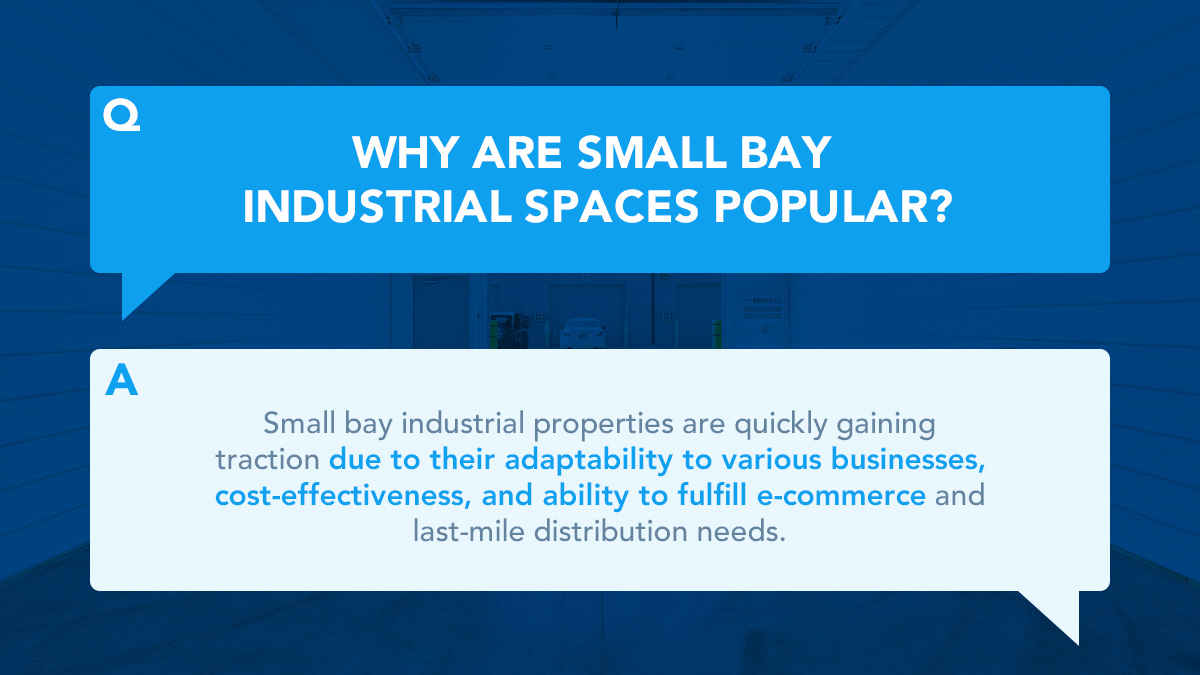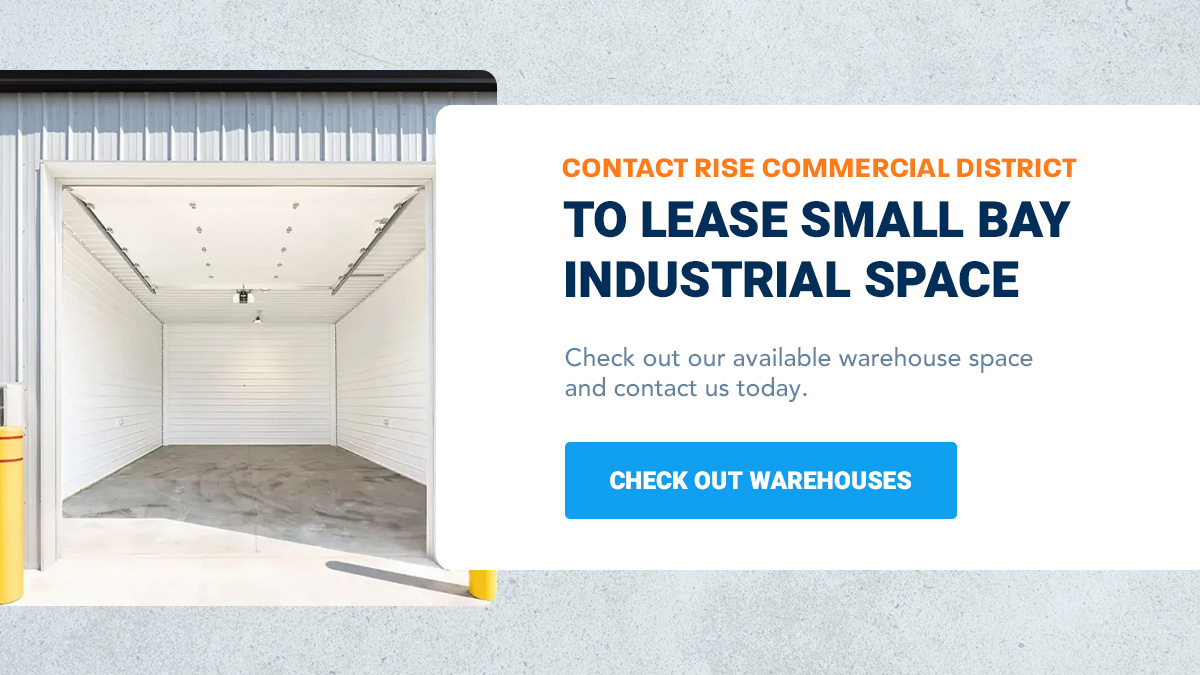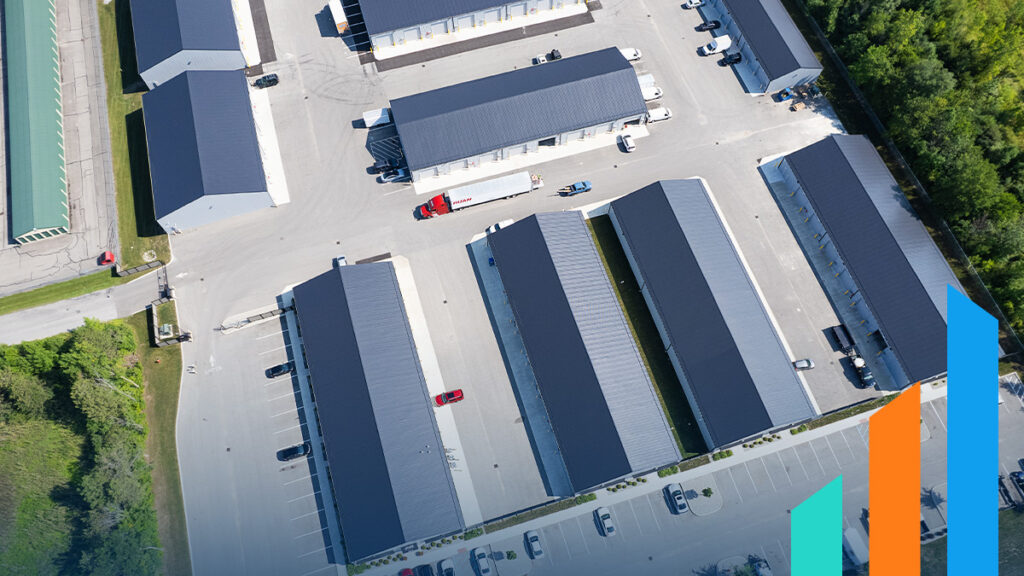- What They Are
- Popularity
- Last-Mile Distribution
- Cost Savings
- Value for Investors
- Leasing
- E-Commerce
- Frequently Asked Questions
- Understanding Small Bay Industrial Spaces
- Why Are Small Bay Industrial Spaces Popular?
- Last-Mile Distribution Capabilities
- Cost Savings for Businesses and Landlords
- Value for Investors
- More Leasing Opportunities
- Impacts of E-Commerce on Demand
- Contact RISE Commercial District to Lease Small Bay Industrial Space
- Frequently Asked Questions
Businesses in several industries are turning to small bay industrial warehouses as a flexible, cost-effective solution to their operational needs. Real estate professionals, small business owners and investors alike can experience unparalleled value from leasing these types of spaces.
Why are small bay industrial facilities surging in popularity? Below, we break down some key factors contributing to their growth.
Understanding Small Bay Industrial Spaces
Small bay industrial spaces are warehouse-style properties with a smaller square footage compared to large, bulk-distribution spaces. Individual tenant spaces and suites can range anywhere from a few hundred to a few thousand square feet.
With flexible layouts and suite sizes, these industrial spaces can accommodate a diverse range of businesses and tenants, from corporations and franchises to small businesses such as HVAC contractors or mom-and-pop shops. Other examples include:
- E-commerce businesses.
- Photography studios.
- 3D printing facilities.
- Trade and construction companies.
- Metal fabrication shops.
- Printing and packaging businesses.
- Art studios and galleries.
- Robotics and automation firms.
- Furniture stores.
- Home improvement suppliers.
Why Are Small Bay Industrial Spaces Popular?

Small bay industrial properties are quickly gaining traction due to their adaptability to various businesses, cost-effectiveness, and ability to fulfill e-commerce and last-mile distribution needs. These qualities make them an attractive option for tenants and investors. In fact, 100 million square feet of small bay warehouse space was added to the market over the past few years.
Let’s look at some factors and market trends driving the growth of small bay industrial spaces.
1. Last-Mile Distribution Capabilities
Most small bay industrial spaces are strategically placed in infill locations in close proximity to customer traffic. This feature makes them perfect for last-mile distribution centers since they’re a short distance from products’ end users. That’s why small bay industrial properties are often known as “last-mile facilities” and are gaining popularity in metro and urban areas.
By being closer to end users and allowing businesses to ship goods directly to customers’ homes or businesses, small bay industrial facilities can accommodate the growing demands of e-commerce and fast-turnaround logistics.
2. Cost Savings for Businesses and Landlords
Because these spaces generally require minimal customization, they’re more cost-effective for tenants to occupy — a considerable benefit in our challenging economic environment.
Small and midsize businesses that want to optimize their operational expenses can particularly benefit from this reduced upfront investment. Lower tenant improvement (TI) costs also translate to faster lease-up times and lower capital expenditures for managers. As such, small bay industrial spaces can be a more efficient, practical investment model than a larger industrial property.
Small bay industrial properties also typically have lower leasing rates than traditional spaces. With the rising costs of industrial real estate rentals, businesses are, understandably, more cost-conscious. Small bay industrial spaces offer an affordable alternative for those looking for functional space without the expensive rates of standard locations.
3. Value for Investors
Small bay industrial facilities appeal to investors because they provide diverse tenancy and, hence, greater cash flow.
These properties often involve triple-net leases, where tenants are responsible for property tax, maintenance and insurance costs for their portion of the space. This structure can offset a large share of operational costs that landlords usually take on in other assets, creating a more stable form of income. In our highly inflated economy, triple-net leases are an attractive option for investors, helping protect their cash flow from high maintenance and insurance expenses.
Additionally, a shorter weighted average lease term (WALT) can be advantageous when rents are increasing. For instance, when market rents surpass current contract rents, a shorter WALT provides a faster way to increase rents to market, boosting property values. It also offers enhanced protection against inflation — property owners can strike market rents more quickly — as opposed to being locked into a fixed-rate, long-term lease.
4. More Leasing Opportunities
With multiple smaller spaces to sublease, small bay facilities often have a larger pool of prospective tenants compared to bulk-distribution, single-tenant spaces.
They’re highly resilient to the fluctuating economic tides because they have more leasing opportunities. More tenants and businesses invest in these smaller spaces than in large-scale industrial properties intended for one specific tenant.
Therefore, small bay industrial buildings draw a wider range of leasing prospects. This helps create more consistent demand across diverse tenants, regardless of changing market cycles and conditions.
Impacts of E-Commerce on Demand
The global e-commerce market is vast and expected to reach $4.32 trillion in 2025. “Last-mile” tenants occupying small bay facilities can be invaluable in the e-commerce sector, helping achieve quicker delivery times.
The e-commerce industry’s continued growth and its increasing retail market share are driving small bay industrial space significantly. This growing demand limits new supply because infill locations are already mostly built out. Additionally, many in-demand urban locations are zoned for higher land-use development needs. These factors collectively contribute to rent growth opportunities for small bay industrial spaces throughout economic cycles.
Contact RISE Commercial District to Lease Small Bay Industrial Space
After exploring the growth of small bay industrial spaces, you might be looking to experience the value for yourself. If you’re interested in leasing small bay industrial warehouse space, our team at RISE Commercial District is ready to help you find a location that suits your needs. Our flexible leasing options are designed to scale with your operations and growth, whether you’re preparing to launch a new product or meet seasonal e-commerce demands.
Check out our available warehouse space and contact us today to request a free quote.

Frequently Asked Questions
Where Should I Lease a Small Bay Industrial Facility?
When selecting the ideal location to lease a small bay industrial warehouse, the following factors can guide your decision:
- Proximity to public transportation systems, grocery stores, restaurants and other essential amenities
- The safety of the neighborhood and surrounding area
- Level of demand for your type of business in the local area
Ultimately, the location you choose should offer substantial opportunities to thrive in the market while providing a safe, accessible space to operate.
What Are Some Typical Features of Small Bay Industrial Buildings?
Here are a few standard features of small bay industrial warehouses:
- Flexible, scalable space configurations
- Easy accessibility for team members and product flow
- Basic utilities, such as HVAC, electricity and water
- Reinforced flooring to accommodate heavy equipment
- High ceilings and wide doorways for freight trucks
- Parking areas for employees and trucks
What Are Some Examples of Small Bay Industrial Trends?
In addition to the typical features of a small bay industrial facility, many of these spaces are incorporating value-added amenities and modern trends, such as:
- Technology integrations: Technology features like advanced monitoring systems, climate control and high-speed Wi-Fi can increase operational efficiency and convenience.
- Security features: Many of these spaces integrate security measures, such as access control systems, video surveillance, alarm systems, and robust physical barriers like fences and gates to protect their staff members and goods.
- Convenient amenities: Consider looking for a small bay industrial warehouse with amenities like shared restrooms and kitchen areas, conference rooms, dumpsters for waste disposal, and loading equipment like forklifts to facilitate inventory management.



